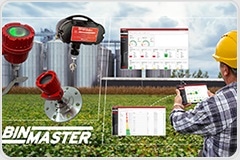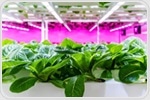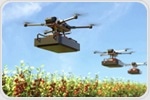
|
|
|
| |

|
|
| |
The latest agritech news from AZoLifeSciences |
|
|
|
 | | |
 Real-Time Bin & Silo Levels Real-Time Bin & Silo Levels
Stop guessing what’s in the bin — see it in real time. Precision sensors + cloud software let you track grain, seed, feed, fertilizer across every silo and site in your operation — no manual checks, no guesswork. BinMaster simplifies supply chain management on your phone or PC.
| |
|
|
| |  | | |  Advancements in nano-agriculture are reshaping pest control, focusing on nanoscale innovations for efficient, environmentally responsible farming practices. Advancements in nano-agriculture are reshaping pest control, focusing on nanoscale innovations for efficient, environmentally responsible farming practices. | | | | |  Advanced UAV sensor integration and machine learning may improve corn AGB predictions, providing scalable solutions for precision agriculture across growth stages. Advanced UAV sensor integration and machine learning may improve corn AGB predictions, providing scalable solutions for precision agriculture across growth stages. | | | | |  Herbicides used in agriculture offer quick weed control but have detrimental effects on the environment and human health, driving the search for safer methods. Herbicides used in agriculture offer quick weed control but have detrimental effects on the environment and human health, driving the search for safer methods. | | | | |  A recent study reveals that vertical farming has a higher carbon footprint than field-grown lettuce, raising questions about UK food security and sustainability. A recent study reveals that vertical farming has a higher carbon footprint than field-grown lettuce, raising questions about UK food security and sustainability. | | | | |  Explore the 2025 agricultural robotics market—growth drivers, key technologies, regional adoption, and challenges shaping the future of farming. Explore the 2025 agricultural robotics market—growth drivers, key technologies, regional adoption, and challenges shaping the future of farming. | | | | |  This study shows CRISPR-Cas9 modifications to the TcNPR3 gene in cacao reduce Phytophthora susceptibility, supporting eco-friendly agricultural practices. This study shows CRISPR-Cas9 modifications to the TcNPR3 gene in cacao reduce Phytophthora susceptibility, supporting eco-friendly agricultural practices. | | | | |  This study presents a concrete mix using agro-industrial waste, achieving 38.8% lower emissions and improved strength, paving the way for sustainable building. This study presents a concrete mix using agro-industrial waste, achieving 38.8% lower emissions and improved strength, paving the way for sustainable building. | | | | |  Hydrogels are key to sustainable agriculture, enhancing water retention and nutrient release, thus improving crop growth and resilience in challenging climates. Hydrogels are key to sustainable agriculture, enhancing water retention and nutrient release, thus improving crop growth and resilience in challenging climates. | | | | |  Millicompost-based substrates enhance bell pepper seedling growth, offering a sustainable alternative to peat and supporting resource-efficient urban farming. Millicompost-based substrates enhance bell pepper seedling growth, offering a sustainable alternative to peat and supporting resource-efficient urban farming. | |
|
|
|  | | | How would you rate today's newsletter?
| |
|
|
|  | | |
 |
Stay updated with the latest in health and medical news! Follow News‑Medical.net on Google News for real‑time updates. Click here to follow us now. |
| |
|
|
|
|
|
|
|